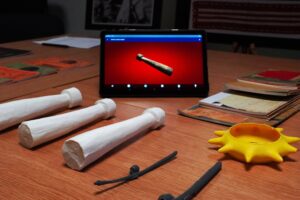
Decolonising the Museum in a Digital World
The project held an exhibition in Edinburgh as part of the ESRC Festival of Social Science, called ‘Decolonising the Museum in a Digital World’ and held over three days (October 28-30). It featured a large-format display of images of artefacts, screening of a short film about the collection, and replicas of some selected artefacts that could be handled by the visitors. Significantly, this was the first public exhibition in the UK dealing with the Gaidinliu Collection. For most visitors, the exhibition was their first encounter with Gaidinliu, her work, and her significance for the Zeliangrong Naga community as a spiritual and political figure.

The Festival was an excellent way to reach out to new audiences within the university and outside, who might otherwise not have the opportunity to learn about the work being done in the DiMuse Project. After extensive fieldwork and pop-up exhibitions among the Zeliangrong community, the present exhibition tried to understand how audiences in the UK think about the question of decolonisation. We sought to engage with the key discourses, issues, practices and forms of intervention that shape the idea of decolonisation and repatriation of cultural heritage in the UK.
An important aspect of the digitisation work undertaken in the project has been the making of replicas. In India, this was done by working with weavers who tried to replicate some of the woven textiles in the Gaidinliu Collection. During the community-curated workshops we also prepared replicas of the notebooks in the collection. For the present exhibition, we worked with uCreate Makerspace, University of Edinburgh’s free community makerspace and fabrication workshop, to develop 3D printed replicas using the 3D photogrammetry models developed in the first phase of the project. These replicas were well-received by visitors—handling the object gave them a different sensory engagement with the collection that went beyond the visuality of large-format displays and film. It is hoped that the project will be able to work with Makerspace to develop further applications for the 3D models. This would include experimentation with immersive virtual reality experiences, and the use of more complex and accurate 3D fabrication techniques.

The event drew a varied audience, with about 25 visitors spread out over three days. There were a number of postgraduate students and researchers from various humanities and social science departments in the university. The display prompted long discussions on the politics of decolonisation, repatriation and indigenous futures. Visitors included curators from local Edinburgh museums, such as the Anatomical Museum and the National Museum of Scotland. They were particularly interested in how the DiMuse project engages with the ethical, political, cultural and technological aspects of repatriation as a process being undertaken by museums across the UK today. Also in attendance were digital manufacturing technicians from uCreate Makerspace, who were very interested in how the 3D-printed models were being used in the exhibition. There were also visitors from outside the university, who wanted to learn more about the process of digital repatriation.
Notwithstanding the limited scale of the event, it was a learning experience that allowed us to experiment with new ideas and modes of presentation, which will be further developed and incorporated into the public exhibition that is to be put up at a later stage in the project. The wide range of responses from the visitors constitute valuable feedback as we work towards developing the DiMuse Digital Museum website, especially with regard to issues of accessibility and interactivity in digitally mediated interactions.